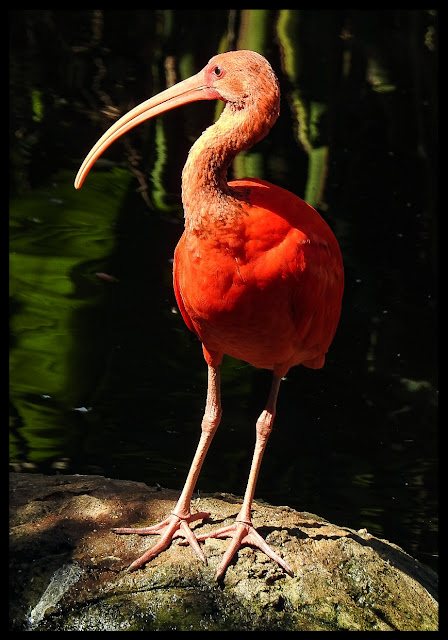The scarlet ibis (Eudocimus ruber) is a species of ibis in the bird family Threskiornithidae. It inhabits tropical South America and part of the Caribbean. In form, it resembles most of the other twenty-seven extant species of ibis, but its remarkably brilliant scarlet coloration makes it unmistakable. It is one of the two national birds of Trinidad and Tobago, and its Tupi–Guarani name, guará, is part of the name of several municipalities along the coast of Brazil.
This medium-sized wader is a hardy, numerous, and prolific bird, and it has protected status around the world. Its IUCN status is Least Concern. The legitimacy of Eudocimus ruber as a biological classification, however, is in dispute. Traditional Linnaean taxonomy classifies it as a unique species, but some scientists have moved to reclassify it as a subspecies of a more general American ibis species, along with its close relative, the American white ibis (Eudocimus albus).

The range of the scarlet ibis is very large, and colonies are found throughout vast areas of South America and the Caribbean islands. Native flocks exist in Brazil; Colombia; French Guiana; Guyana; Suriname; and Venezuela, as well as the islands of the Netherlands Antilles, and Trinidad and Tobago. Flocks gather in wetlands and other marshy habitats, including mud flats, shoreline and rainforest. Outlying colonies have been identified in the coastal areas of the states of Espírito Santo, Rio de Janeiro, São Paulo (for example in the Santos-Cubatão mangroves of the Baixada Santista district), Paraná and Santa Catarina. In recent years, bird colonies can be seen as far south as in the coastal areas of Joinville and the island of São Francisco do Sul.

Mating pairs build nests in a simple style, typically "loose platforms of sticks" of a quality sometimes described as "artless". They roost in leaf canopies, mostly preferring the convenient shelter of young waterside mangrove trees. Scarlet ibises like wet, muddy areas such as swamps, but for safety they build their nests in trees well above the water. If they can, they nest on islands, where their eggs and chicks are less likely to be in danger from predators.
To attract a female, the male will perform a variety of mating rituals such as "preening, shaking, bill popping, head rubbing, and high flights. As with most birds, mating does not involve any coupling or insertion: instead, a transfer of seminal fluids occurs during external contact between the cloacal openings. After a gestation period of five to six days, the female lays a clutch of three to five smooth, matte eggs which typically incubate for 19–23 days. After a successful courtship, pairs remain faithful and cohabitant, sharing parental responsibilities for the young.






%201.jpg)





















%2021.jpg)